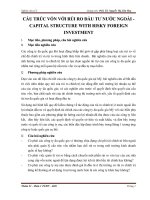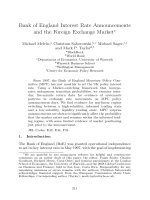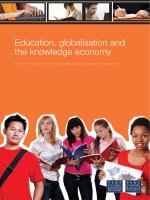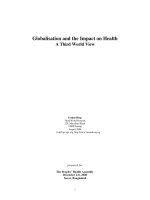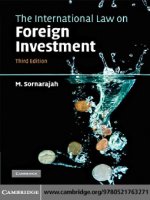Globalisation and korean foreign investment
Bạn đang xem bản rút gọn của tài liệu. Xem và tải ngay bản đầy đủ của tài liệu tại đây (16.25 MB, 220 trang )
GLOBALISATION AND KOREAN FOREIGN INVESTMENT
To Sara and Chang-Hee
with love
Globalisation and Korean
Foreign Investment
'Edited by
JOHN A. TURNER
University of Surrey
YOUNG-CHAN KIM
University of London
First published 2004 by Ashgate Publishing
Reissued 2018 by Routledge
2 Park Square, Milton Park, Abingdon, Oxon OX14 4RN
711 Third Avenue, New York, NY 10017, USA
Routledge is an imprint of the Taylor & Francis Group, an informa business
©John A. Turner and Young-Chan Kim 2004
John A. Turner and Young-Chan Kim have asserted their moral right under the
Copyright, Designs and Patents Act, 1988, to be identified as the editors of this work.
All rights reserved. No part of this book may be reprinted or reproduced or utilised
in any form or by any electronic, mechanical, or other means, now known or
hereafter invented, including photocopying and recording, or in any information
storage or retrieval system, without permission in writing from the publishers.
A Library of Congress record exists under LC control number: 2004007701
Notice:
Product or corporate names may be trademarks or registered trademarks, and are
used only for identification and explanation without intent to infringe.
Publisher’s Note
The publisher has gone to great lengths to ensure the quality of this reprint but
points out that some imperfections in the original copies may be apparent.
Disclaimer
The publisher has made every effort to trace copyright holders and welcomes
correspondence from those they have been unable to contact.
ISBN 13: 978-0-815-38924-8 (hbk)
ISBN 13: 978-1-351-15736-0 (ebk)
Contents
List of Figures
List of Tables
List of Contributors
Acknowledgements
vii
viii
x
xi
1
Introduction: Interpreting the Idea of a Global Economy
John Turner and Young-Chan Kim
1
2
The Theory of Korean Foreign Direct Investment
Young-Chan Kim and Yongrok Choi
17
3
Paradoxes of Globalisation: Some Thoughts on a Much
Abused Concept
Carlos A . P. Machado
39
4
Global Capitalism and the Asian Financial Crisis
DouglasJ. Sikorski
60
5
Korean Direct Investment in EU: Global Koreanisation
Judith Cherry
81
6
Inward Foreign Direct Investment Policy and Practice: an
Anglo-Korean Comparison
John Turner and Young-Chan Kim
106
7
Globalisation or De-Globalisation: What Role for the World
Trade Organisation?
Stephen Young and Thomas L. Brewer
134
Globalisation and Korean Foreign Investment
VI
8
Whither Global Capitalism?
John Dunning
Bibliography
Index
153
192
204
List of Figures
2-1
2-2
2-3
2-4
2-5
2-6
2-7
2-8
2-9
2-10
2-11
5-1
5-2
6-1
6-2
8-1
8-2
8-3
8-4
8-5
8-6
8-7
Foreign Direct Investment vs. Export toward N. America
Production Decision by Factor Analysis
Foreign Direct Investment vs. Export toward S. Asia
Synthesis of Foreign Direct Investment theories
Foreign Direct Investment Trend by Invested Total
Amount and Projects
Foreign Direct Investment Trend by Industry
Foreign Direct Investment by Industry
Foreign Direct Investment by Manufacturing Type
Foreign Direct Investment by Region
Foreign Direct Investment Trend by Size
Foreign Direct Investment by Equity Ratio
The Business Environment and Korean Government
Policy 1963-1986
Changes in the Business Environment and
Korea Government Policy 1987-1996
IBB Organisation Chart in 2000
KISC Organisation Chart in 2000
The Institutions of Global Capitalism
Market
Intermediate Associations
Government
Supra-National Entities
The Moral Understanding of the Global Capitalism
Diamond
Illustrations of Three Perceived Ways in which Global
Capitalism Might Fail
19
20
23
25
27
30
31
32
33
34
35
98
99
124
125
162
164
167
171
175
180
185
List of Tables
45-1
5-2
5-3
5-4
5-5
5-6
5-7
5-8
6-1
6-2
6-3
6-4
6-5
6-6
677-2
7-3
7-4
7-5
1 Pre-Crisis Current Account Balances
Korean Foreign Direct Investment, 1968-1996
Korean Foreign Direct Investment: By Sector, 1968-1979
Korean Foreign Direct Investment: By Region, 19681979
Korean Foreign Direct Investment: By Sector, 1980-1985
Korean Foreign Direct Investment: By Region, 19801985
Korean Foreign Direct Investment: By Sector, 1986-1996
Korean Foreign Direct Investment: By Region, 19861996
Korean Foreign Direct Investment in the EU and the
World, Annual Growth Rates, 1968-1996
Inward Foreign Direct Investment by Industrial Sector
1962-1972
Inward Foreign Direct Investment by Industrial Sector
1973 -1978
Foreign Loans and Direct Investment 1959-1980
Foreign Direct Investment: Liberalisation Status, 1980November 1992
Foreign Direct Investment on an Arrival Basis 1962-1990
Foreign Direct Investment by High-Technology Foreign
Companies in Korea
7 Inward Foreign Direct Investment Proportions by
Country
1 The Uruguay Round - Investment Related Agreements
The World Trade Organisation and Globalisation - Areas
of Inquiry
Summary Features of Uruguay Round Agreements
Relevant to Investment-Related Issues
Trend Over Time in Number of GATT and World Trade
Organisation Dispute Cases
Selected Patterns of World Trade Organisation Dispute
Cases, January 1 ,1995-December 31 1998
63
82
84
85
86
87
90
91
95
109
111
113
116
117
120
122
138
139
140
142
143
L ist of Tables
8-1
8-2
8-3
8-4
8-5
8-6
8-7
8-8
Feature of Three Stages of Market Based Capitalism
Some Indices of Globalisation
Cause of Global Capitalism
Three Possible Future Scenarios of Global Capitalism
The Governance of Global Capitalism
The Impact of Global Capitalism on the Role of
National and Sub-National Governments
What are the particular Moral Virtues which a
Knowledge and Alliance Based Globalising Economy
Demands?
Illustrations of Four ‘Failures’ of Global Capitalism as
Revealed in the Case of Recent Economic Events in
Seven Countries
ix
157
158
159
161
162
174
181
187
List of Contributors
Thomas L. Brewer, Copenhagen Business School
Judith Cherry, Sheffield University
Yongrok Choi, Inchon University
John Dunning, Reading and Rutgers University
Young-Chan Kim, Royal Holloway, University of London
Carlos A. P. M achado, Universidade de Minho
Douglas J. Sikorski, National University of Singapore
John Turner, University of Surrey
Stephen Young, University of Strathclyde
Acknowledgements
The editors are pleased to acknowledge the support of the Embassy of the
Republic of Korea, especially Dr. Ra, Chong-11 and of the Rt. Hon. Lord
Parkinson for the conference at which early drafts of some of the papers were
discussed, and the support of the Economic and Social Research Council for
the research underpinning Chapter 6.
They also acknowledge the forbearance of Brendan George and Caroline
Court at Ashgate, C. H. Kang for editing support, and of our contributors.
Our families, as ever, have been sympathetic to the disruptions caused by
globalised study.
1 Introduction: Interpreting
the Idea of a Global
Economy
JOHN TURNER AND YOUNG-CHAN KIM
The global economy at the beginning of the 21st century can seem like a man
caught half way up a cliff - he cannot go up, he cannot go back, but if he stays
where he is he will die.1 This book has grown from a vigorous seminar on
‘globalisation and de-globalisation’, which was first prompted by a shared
interest in the impact of the 1997 Asian economic crisis. Trying to understand
the impact of this severe shock to global expectations of smoothly
accelerating prosperity, the participants began to combine a direct, evidencebased analysis of current activity with a more profound and reflective analysis
of long-term change. Since the group included a politician and a diplomat as
well as academic economists, political scientists, management specialists and
historians, the debate was lively and eclectic. The resulting volume will irritate
purists in any of these disciplines.
‘Globalisation’ is as enveloping and imperialist a word as ‘progress’ - a
concept which in some quarters it has almost come to subsume. Carlos
Machado in his essay below on the paradoxes of globalisation anatomises the
dozens of definitions and half-definitions which scholars have used
promiscuously in the last fifteen years. A common feature is the belief that
there has been a huge change in degree, and possibly in kind, of long-distance
and trans-national trade which generates ‘the process whereby the population
of the world is increasingly bonded into a single society’ with a common
culture and common values (Kilminster, 1997, citing Albrow, 1992). One
might observe that this is a state of becoming, not of being, as witness the
frequent small genocidal wars in which both sides fight with Kalashnikov
rifles bought on the open international market. If the establishment of a
‘single society’ is globalisation, it has not yet come about; the ‘end of history’
(Fukuyama, 1992) has not quite happened; and there is a lot of work still to do
in the historical analysis of the underlying processes. This introductory paper
sets out some of the problems in a long historical context, notes the variety of
interpretation (of both past and future) which this long-run perspective
permits, and indicates how the rest of the book seeks either to answer or re
state the issues raised.
2
Globalisation and Korean Foreign Investment
Globalisation as history
Let us take as a fixed point on a very uncertain map the proposition that the
historical changes we are examining are principally described, if not
determined, by economic change. A stylised history of the last three thousand
years would probably emphasise that human communities at the beginning of
the period acquired most of the means of subsistence within a very small area.
Over time the development of transport and of stable governmental systems
over larger areas of the world made it possible to increase the proportion of
material needs which were acquired from long distances. Evidence for
prehistoric trade in low-bulk, high-value items over thousands of kilometres
merely emphasises the small proportion of life’s necessities which could be
acquired in that way. A presupposition of the globalisation thesis is that
industrialisation made it possible to generate larger surpluses above
subsistence, and to transport of this surplus over longer distances in greater
bulk. The result was a global division of labour in which certain areas had a
comparative advantage in primary production and others in industrial
manufacture; a complex international economy grew up to engineer the
exchange of needs between the two areas. Thus by the end of the 19th century,
the leading European industrial nations were importing a high proportion of
their basic foodstuffs and raw materials, and exporting manufactured goods in
return. At the same time there was a high volume of trade between
industrialised countries, and an international capital market which allowed the
large surpluses of industrial countries to be invested wherever the returns were
most attractive. National economies were highly interdependent, though
growth rates differed quite dramatically, and business cycles were as yet not
fully synchronised. While large areas of subsistence economy remained, even
in Europe, the process of economic globalisation was well under way by the
outbreak of war in 1914. Modem interpretations of the origins of that war
emphasise the struggle for position in a global economy, rather than the
‘European civil war’ which was how the conflict was routinely viewed in the
mid-twentieth century (Offer, 1989).
If this stylised history is extended into the 20th century, it conventionally
recognises that the Great War was a major setback to globalisation.
International trade collapsed and did not recover in volume until 1980s. The
free movement of capital was also restricted by the war and the post-war
financial settlements on reparations and war debts, and by the appearance of
political regimes in Europe from the 1920s onwards which preferred autarky
to an open trading system. World War II, followed in short order by the Cold
War, did little to help. The aspirations of the post-war setdement, from the
Bretton Woods agreement of 1944 to the establishment of the General
Agreement on Tariffs and Trade (GATT) in 1947, were towards an open
international financial and trading system. The practicalities were different.
The Bretton Woods system established the dollar as a freely exchangeable
Introduction: Interpreting the Idea o f a Global Economy
3
international currency only where other, largely political factors did not restrict
the free movement of goods and capital. The GATT system took decades to
chip away at an immense structure of protective devices erected by
industrialised countries. Comecon cut off Eastern Europe from free trade
with the rest of the world; the European Free Trade Area was clearly intended
to restrict the freedom of trade with countries outside Europe, as was the
European Common Market.
Ostensibly the climate only began to change in the 1980s. Restrictions on
capital export, which most countries had maintained since World War II,
began to relax. Serious efforts were made to create regional free trade areas.
The creation of a Single European Market (SEM) by the process culminating
in the 1992 Maastricht treaty was perhaps the clearest example of a real free
trade area being created out of an institution which had only been pretending
for 30 years. The emergence of the North American Free Trade Area
(NAFTA), at the instigation of the United States (US), was somewhat more
ambiguous since it was far from an agreement between equals. The collapse of
the Soviet sphere of influence promised to allow Eastern Europe and Russia
back into the international economic community, while the steady ‘reform’ of
the Chinese economy promised that it, too, would soon be participating fully.
At the same time capital movement was encouraged by the development of
global financial markets relying on improved telecommunications to trade
effectively across national and regional borders. Not only were financial
institutions legally allowed to operate internationally, they increasingly had
access to communication and information flows which allowed them to do so
profitably.
Alongside the rather spasmodic re-emergence of the political and financial
conditions for a globalised economy, the growth of multinational enterprises
(MNEs) has made sure that more and more business will be done across
national boundaries, though it coincidentally made it much more difficult to
observe the volume or nature of that business. MNEs can move goods, and
increasingly services, across the world, seeking the best location for
manufacture and for sourcing raw materials, semi-manufactured goods and
finance. Those authors who were warning ominously in the 1970s of a
growing ‘meso-economy’ in which international corporations would have
grown larger, more powerful and more deadly than nation states have certainly
not yet been proved wrong (Holland, 1975: 44—94). The cultural impact of
MNEs, especially those with interests in consumer goods and consumer
services, has also been prominent: the idea of an international brand, be it
Coca-Cola, Sony, or Windows 2000, clearly strengthens the idea of a global
market without borders.
Thus the stylised history arrives at the beginning of the 21st century and
changes gear from history to futurology. What faces the world economy is not
a cross-roads, with two contrasting paths to follow into clearly different
4
Globalisation and Korean Foreign Investment
futures, but a spectrum of possible futures in which any of the conflicting
trends of the last century might become dominant, and thus determine the
future. At one extreme is the possibility that, notwithstanding a setback lasting
since 1914, the world economy is indeed set to become a single global market
in a ‘single society5, much as the creation of national markets in 18th and 19th
century European nations contributed to the making of national societies. At
the other extreme, the increasing scale and speed of cross-border transactions
might simply elicit new politico-economic blocs, such as the European
Union(EU), which will find themselves in the sort of supposedly
irreconcilable competition which interrupted the last thrust to globalisation in
1914. Awareness of the strong likelihood that the outcome will lie somewhere
between these two extremes does not help us very much to determine its most
likely shape.
We can, however, reflect usefully on the considerations which are likely to
set the direction of the future of global society. The first of these is the
interaction of the global economy and the nation state, both of which have
seen their definitional boundaries fray in the last three decades. The second is
the potentiality of the globalised economy to deliver steady and accelerating
per capita growth to a growing population. The third is the impact of global
economic change on the evenness of economic development across the
world: another of the welfare consequences of globalisation. The fourth is the
potentiality of a global economy to develop effective global institutions of
governance, or to create its own ‘civil society5: the World Trade Organisation
(WTO) has made an uncertain start as a governing institution, and the claim
that international non-governmental organisations (NGOs) can be the basis of
a ‘global civil society5is as yet unproven. The papers in this volume address all
but the second of these considerations, not to prophesy but to illustrate the
complexity and conflicting evidence which underpins the ‘facts on the ground5
which are themselves the stuff of prophecy.
Globalisation and the nation state
Late 20th century discussion of globalisation tended to take the nation state for
granted, while groping towards the realisation that more and more of the
phenomena which affect the lives and lifecycles of human beings are either
sub-national or supra-national in their focus. But the development of a global
market has taken place at the same time as the parallel development of the
nation state, which itself has been closely associated with the industrialising
societies of 18th and 19th century Europe and North America. Not for nothing
has the world economy been routinely described, in English at any rate, as the
‘international5 economy, for neither economists nor political scientists have
been able to think of a world economy without nations in it. Moreover, much
of the discussion of the impact of globalisation has centred on its propensity
Introduction: Interpreting the Idea o f a Global Economy
5
to weaken or damage the nation state or to provoke conflict between nation
states. It is therefore worth looking briefly at the long-run interaction between
the nation state and the world market.
Two long-run perspectives on the emergence of the nation state have
become established among historians, neither of which seriously
acknowledges the positioning of the nation state in a world economy. Writers
on the early modem period in Europe —roughly from the late 15th century to
the Enlightenment at the end of the 18th century —have developed the idea of
the ‘military-taxation state’, whose origins lay in the need felt by ambitious
princes to develop taxation systems to fund their increasingly expensive
military expeditions. This culminated in the work of the ‘enlightened despots’
of the 18th century who erected large bureaucracies to collect taxes, organise
land reform, count populations, promote technical education and scientific
research, and stimulate industry, all in the interests of producing a larger,
stronger and more cohesive military forces. Save for the appearance that
economic growth has latterly become an end in itself rather than a means to
military expansion, there was not a little in common between the ambitions of
late 18th century Prussia, France and Austria and those of the ‘developmental
states’ of late 20th century Asia. The ‘military-taxation state’ was the
foundation of the governing institutions of the 19th century European state:
ministries of defence, police, finance, trade, and education grew up as
bureaucratic agents of the sovereign body, and could be agents just as well of
a republic or a constitutional monarchy as of an autocratic emperor.
The late 18th century great powers certainly knew what they were and
what they wanted, and their governments operated economic and social
policies accordingly. In outline, most were interested in developing
rudimentary human capital, either in the form of skilled workers or numerous
and healthy potential soldiers; most were interested in accumulating resources,
and thus tended to operate protective tariffs and ‘bullionist’ policies towards
international trade. Territorial acquisition, especially of areas rich in primary
resources, was more readily understood than the benefits of commerce. Spain,
Portugal, France, Britain and the Netherlands duly acquired areas of territory
outside Europe, principally in India and the Americas, and fought over it for
most of the 18th century. A practice of international relations which, if not
stable, was well understood was finally disrupted by the double impact of the
massive productivity growth of the late 18th century which allowed Britain to
increase its international trade dramatically, and the Revolutionary and
Napoleonic Wars between 1793 and 1815, which disrupted the European
states system.
At the Congress of Vienna in 1815 the victorious anti-French alliance
thought that it had thwarted the destructive and revolutionary processes
launched by the Jacobins and carried on by Napoleon Bonaparte and restored
the ancien regime,. In the event, though many aspects of the old order proved
6
Globalisation and Korean Foreign Investment
extremely robust, a new form of state was beginning to appear alongside
military-taxation states. The nineteenth century nation state was based on
claims about the right of ethnically and culturally homogenous groups to selfdetermination. This right had first been asserted, with French support, against
the claims of the Austrian and Russian emperors to govern the diverse
populations of Central Europe. By emphasising the identity of the state with
its population - rather than its rulers - this was subversive of monarchical
government as much as it was destructive of the old empires. For all its
insurgent energy, this new political life-form took about a century to establish
itself as the dominant form of political organisation across Europe. The state
which most successfully established itself around the idea of ethnic
homogeneity was in fact not an insurgent: Prussia, an archetypal militarytaxation state, had by 1871 absorbed the overwhelming majority of German
speaking territories outside Austria and reinvented itself as the German
Empire. But the dynamic appeal of the ‘ethno-political5 state strengthened
steadily. Greece established its independence of the Turkish Empire. Italy was
created from the remnants of three moribund regimes in the Italian peninsula,
and the Savoyard monarchy, which had brought about this risorgimento, set
about imposing a linguistic homogeneity to justify the creation of a nation
state. France, after a number of false starts and a major military defeat at the
hands of Prussia in 1871, was consolidated under the Third Republic as a
major industrial power with an acute sense of national identity.
There was thus by the beginning of the twentieth century a ‘world order5
which encompassed the military and economic power, and the territorial
influence, of a small number of nation states, each of which supported a
subtly different relationship between ethnic coherence and political integration.
France, Germany, Italy and Japan were, at least in theory, ethnically coherent
nation-states; the Austrian, Russian and British empires were self-consciously
multi-national each with a metropole (Austria-Hungary had two) and a
dependent periphery; the US eschewed ethnicity altogether as a concept
justifying its existence and represented itself as a political system whose
members were all immigrants or the children of immigrants. What tied the
states into a system was a shared military technology and participation in an
international economy. The economic hegemony of the industrialised powers
and the openness of most of the non-industrialised world to trade created a
genuinely international economy in which raw materials, intermediates and
semi-manufactured goods were, with a few important exceptions, traded freely
across the planet. The attempts by nation states to control cross-border trade
or movement of economic migrants were important politically —in that the
maintenance of tariffs and other trade barriers appealed to nationalism and
xenophobia and won electoral support for some politicians in most of the
countries named - but they did little to inhibit the development of a genuine
economic interdependence amongst the industrialised powers and between
Introduction: Interpreting the Idea o f a G lobal Economy
7
the industrialised powers and the rest of the world, based on their mutual
needs for goods manufactured with comparative advantage and for food and
raw materials. A de facto adherence to a gold standard for international
payments created a stable framework for this international trade.
The world order of the first decade of the twentieth century was thus
arguably ‘globalised’ in a meaningful sense, which was palpably injured by the
political and economic outcome of World War I. In Europe the Paris Peace
Conference in 1919 deliberately created ethno-political states in place of the
Austro-Hungarian empire, but also created a system by which the new League
of Nations, through its ‘Mandates’, parceled up even more of the nonEuropean world in the empires of the victorious powers. Even more
destructive of the tendency to globalisation was the policy developed at the
Paris Economic Conference of 1916, at which France and Britain agreed to
maintain trade barriers against Germany after the war. The pursuit of
nationalist economic policies during the post-war recession sharply restricted
cross-border trade, despite the attempts by central bankers to develop
international economic institutions and practices which would create a stable
monetary environment for the international economy. Attempts to re-create
an international gold-based economy, led by Britain and the United States, fell
apart after the 1931 crash.
There was thus a considerable impetus to international economic reform
after the Second World War, but this could, and can, only be understood in
the context of political and military competition between nations and,
eventually, supra-national blocs. On the one hand, the global economy
acquired its own regulatory institutions and practices: the World Bank (a
development fund), the International Monetary Fund (a bank established to
be a lender of last resort for national central banks), and the GATT. On the
other hand, these institutions could only exist because of the enormous
economic power of the US, and their working assumptions were consistent
with the policy preferences of US governments. The US began to work on
free trade, in the sense of free access for American goods into other national
markets, during the war. American economic support for the British war
effort was conditional on a British promise to drop its trade barriers after the
war. American support for reconstructing European economies under the
1949 Marshall Plan was conditional on the adoption of liberal economic and
political policies by the beneficiaries. While it can be, and was, argued that this
was in die general interest of the receiving countries because such policies
would increase the total volume of trade and thus increase welfare, it was also
easy to represent it as American economic imperialism. Similar policies were
applied in occupied Japan after its postwar reconstruction and to a lesser
extent in Korea after the Korean war of 1951.
As a result there were at least two world economies for most of the last
half of the twentieth century, reflecting the political polarization of the Cold
8
Globalisation and Korean Foreign Investment
War. In the W est’ (which of course included much of East and South East
Asia and of Central and South America), national economies were conducted
as part of a world trading regime which preferred, but could not insist on,
steadily reducing tariffs and the reduction of non-tariff barriers to trade.
Within the ‘East’ (which included the Soviet bloc, China, and a few dependent
countries in Asia and the Americas), there was a good deal of international
trade which was controlled by governments and sometimes even by barter
arrangements rather than by tariffs. Trade between the two blocs was limited.
The less developed areas of Africa and South Asia were in the world economy
only to the extent that they participated asymmetrically in the production of
food and raw materials and the import of manufactured goods.
Even the Western economy of the late twentieth century differed
significantly from the globalised economy of a hundred years before. On the
one hand, national governments had retained their strongly interventionist
attitude to national economies, for reasons of domestic politics as much as
anything else. The Keynesian toolbox, superseded after the mid 1970s by the
Friedmanite toolbox, enabled and encouraged governments to tinker with the
growth rates of their national economies. Many nation states sought to
develop particular industries or areas of manufacturing capability, or to
protect those whose decline threatened social stability. In the US and within
the European Common Market, governments also protected agriculture,
largely for political reasons. All these interventions tended to dampen the
impact of the world economy on economic activity within states, and
contrasted strongly with the largely unfettered flows of food, raw materials,
manufactured goods and even traded services around the much smaller
‘international economy’ of the late nineteenth century. Another feature of the
nineteenth century international economy which was not fully replicated in the
latter twentieth century was the unfettered flow of human capital across
national borders. Immigration into the advanced industrial countries was
much more controversial than in the previous century, partly because it was
associated with the untidy dissolution of colonial empires, but its economic
impact was much smaller because of enforced restrictions intended to limit
‘economic migration’.
Another manifestation of difference was the role of the MNEs in a period
of growing industrial concentration. MNEs were an important part of the
international economy from the late nineteenth century onwards. As noted
above, Stuart Holland and other authors began to fear out loud in the 1970s
that MNEs would before too long be able to exercise more economic power
than national governments. Certainly there were already by that time a number
of MNEs with a turnover larger than many sovereign states, but the MNEs in
question were almost without exception American and the sovereign states
were still among the smallest. Nevertheless, for the time being, most MNEs
were clearly domiciled somewhere and operated within a particular national
Introduction: Interpreting the Idea o f a G lobal Economy
9
economic context. The largest were multinational producers of consumer
goods such as foodstuffs, consumer electronics or cars, and as such they were
often associated with international brands. limitations on capital export, and
sometimes on capital import, operated by most countries between 1945 and
the 1970s meant that new direct investment in plants or enterprises overseas
was difficult even for large companies. A characteristic example of an MNE
affecting a national economy would therefore be an American or British
company, probably established since long before World War II, taking
decisions about employment in its foreign subsidiary: plants in Liverpool or
Singapore would be closed by faceless men in Detroit or London, whose
offence was that they were foreign, often American, as much as that they were
not accountable to government. National governments often responded by
nationalist policies, creating and subsidizing ‘national champions’ in industries
thought to be critical to the prosperity or economic stability of the national
economy, and correspondingly pushing forward the interest of their ‘own’
multinationals in foreign investments.
In 1976 the OECD adopted a set of ‘guidelines for multinational
enterprises’, giving the following reasons:
Multinational enterprises now play an important part in the economies of
Member countries and in international economic relations, which is of increasing
interest to governments. Through international direct investment, such
enterprises can bring substantial benefits to home and host countries by
contributing to the efficient utilisation of capital, technology and human
resources between countries and can thus fulfil an important role in the
promotion of economic and social welfare. But the advances made by
multinational enterprises in organising their operations beyond the national
framework may lead to abuse of concentrations of economic power and to
conflicts with national policy objectives. In addition, the complexity of these
multinational enterprises and the difficulty of clearly perceiving their diverse
structures, operations and policies sometimes give rise to concern.2
The Guidelines were published in the middle of a period of global
transition catalysed by 1973 oil crisis, and also reflected widespread concern
about the impact of MNEs on employment rights and welfare in host
countries. The OECD could neither enforce its guidelines, despite the
establishment of a Committee on International Investment and Multinational
Enterprises (CIME) with business and trade union representation; nor could it
change the course of history, which flowed on much as predicted. At the end
of the century CIME reviewed the guidelines and concluded that MNEs, the
economic context, and national government behaviours had all changed.
MNES were more widespread; fewer of them were American; governments
tended to intervene in the economy in a different way; and in particular were
10
Globalisation and Korean Foreign Investment
more likely to welcome foreign direct investment (FDI) and to influence
business behaviour indirectly by setting the economic context, rather than by
direct regulation. More generally
Looking now at conditions today, over twenty years after adoption of the
Guidelines, we are faced from the very start with the phenomenon commonly
called ‘globalisation’, or, as it might better be called, ‘global integration.’ The
process is still uneven and asymmetrical, in terms of the countries and regions
involved as much as the particular economic sectors and industries. Still, it cannot
be gainsaid that it is increasingly bringing national economies closer together; the
world economy tends to function, not as an aggregation of discrete national
economies, but as a single economic system. The walls around national territories
that have historically allowed national economies to function in selective isolation
from one another and from the world market, thus lending effectiveness to
government measures of intervention in the economy, are now being lowered.
FDI is a most important element in this process and MNEs have been its
principal architects as well as beneficiaries.3
The OECD, and governments, had come to take more seriously the
potential of the MNE to move goods and services around the world quite
freely, using internal transfer prices to regulate the economic and fiscal
consequences. Where the balance of power had remained, broadly, with the
governments in 1976, by 1998 it was perceived to lie more with the MNEs,
and the concern was not simply about welfare and employment rights but
increasingly about the macro-economic impact of capital movements and the
impact of MNEs on the environment. An MNE which had its legal
headquarters in one country, its markets in many others, and its
manufacturing capacity distributed across another set of countries, some with
and some without large markets for its products, could be a formidably
complex institution to manage or to deal with. The concepts of ‘ownership’,
with a globally distributed body of shareholders, or ‘control’, with an executive
group drawn from any of a number of subsidiary companies and national
elites, are no longer what they were.
In that way, global integration has clearly eroded the autonomy of the
nation state with respect to its economic policy. It has also interacted
significantly with another cause of dilution of autonomy, the development of
international collaboration through economic blocs. Most restrictive
international trading agreements have been extremely porous, and the work of
GATT and its successor the WTO has tended in general to reduce the impact
of collaborative agreements between nations on the freedom of trade. The
major exception to this tendency has been the evolution of the EU into a
single market protected by a common external tariff. The EU began its life in
the post-war years with a political dynamic, driven by Franco-German
Introduction: Interpreting the Idea o f a Global Economy
11
determination to reduce the potential for conflict within Western and AngloAmerican desire to consolidate the western alliance against Russia, in both
cases using economic measures as instruments. Economic integration hardly
became an end in itself until 1986, when largely at the instigation of the British
government the creation of the Single European Market (SEM) was agreed.
The requirements of the SEM for harmonization and the removal of internal
non-tariff barriers to trade were formidable, and fulfilled a British agenda for
general economic liberalization. European states were much less able than
before to protect their domestic industries from competition from other
European states. This had the predictable result that rationalization within the
EU reduced the number and increased the size of firms in most capitalintensive sectors; the former ‘national champions’ in the key areas of cars,
computers and pharmaceuticals ceased to exist, and even the defence and
aerospace sectors began to come together in collaboration over major projects.
More interesting for understanding ‘globalisation’ was the effect of the
SEM on inter-firm collaboration and direct investment across the tariff wall
around ‘Fortress Europe’. In many of the largest sectors of industry, the
potential size of the European market is now as great or greater than that of
the US, and enlargement of the Union will certainly make it so in even more
sectors before long. The rewards for entry into this market are
correspondingly high, but because of the competitive advantage of larger
capital-intensive European enterprises, the costs of entry are also extremely
high. The tariff barrier, as it was intended to do, tends to reduce the cost
advantage of manufacturing cheaply outside the EU in order to sell profitably
inside it. The opportunities and challenges for MNEs are enormous.
In that way, global integration has clearly eroded the autonomy of the
nation state with respect to its economic policy. It has also interacted
significandy with another cause of dilution of autonomy, the development of
international collaboration through economic blocs. Most restrictive
international trading agreements have been extremely porous, and the work of
GATT and its successor the World Trade Organisation has tended in general
to reduce the impact of collaborative agreements between nations on the
freedom of trade. The major exception to this tendency has been the
evolution of the European Union into a single market protected by a common
external tariff. The EU began its life in the post-war years with a political
dynamic, driven by Franco-German determination to reduce the potential for
conflict within Western and Anglo-American desire to consolidate the western
alliance against Russia, in both cases using economic measures as instruments.
Economic integration hardly became an end in itself until 1986, when largely
at the instigation of the British government the creation of the Single
European Market was agreed. The requirements of the SEM for
harmonization and the removal of internal non-tariff barriers to trade were
formidable, and fulfilled a British agenda for general economic liberalization.
12
Globalisation and Korean Foreign Investment
European states were much less able than before to protect their domestic
industries from competition from other European states. This had the
predictable result that rationalization within the EU reduced the number and
increased the size of firms in most capital-intensive sectors; the former
‘national champions’ in the key areas of cars, computers and pharmaceuticals
ceased to exist, and even the defence and aerospace sectors began to come
together in collaboration over major projects.
More interesting for understanding ‘globalisation’ was the effect of the
SEM on inter-firm collaboration and direct investment across the tariff wall
around ‘Fortress Europe’. In many of the largest sectors of industry, the
potential size of the European market is now as great or greater than that of
the United States, and enlargement of the Union will certainly make it so in
even more sectors before long. The rewards for entry into this market are
correspondingly high, but because of the competitive advantage of larger
capital-intensive European enterprises, the costs of entry are also extremely
high. The tariff barrier, as it was intended to do, tends to reduce the cost
advantage of manufacturing cheaply outside the EU in order to sell profitably
inside it. The opportunities and challenges for MNEs are enormous. There is
now a long history of inward investment from outside the EU generated by
major companies both from the major developed economies - the United
States and Japan - and from the developing economies of East and South
East Asia, intending to secure markets both for consumer goods and for
intermediate goods by manufacturing or assembling products within the
Union’s borders. The response from Europe has been mixed, varying from
the enthusiasm of Britain over a period of two decades to a distinct suspicion
on the part of French governments. Inward investment activities have been
wrapped around with complexities, as national governments and the EU itself
have worried about the cost and benefits of the investments themselves, the
relation between investment subsidies and competition policy, and the
requirement that goods manufactured within the tariff barrier should have a
specified proportion of ‘local content’ to ensure that the investment was not a
tool to frustrate the purpose of the common tariff.
Korea and Globalisation
In this new economic world order, the position of dynamic developing
economies is especially fluid. A small number of Asian economies grew so
rapidly after the oil crisis of the 1970s that until the middle 1990s these ‘Asian
tigers’ were being taken for a paradigm case of successful industrialisation and
modernisation. Most of them - particularly Malaysia, Singapore, Taiwan and
Korea — had political systems which were robusdy authoritarian though
otherwise very different from one another, and the most common
explanations of their success included the proposition that economic growth

